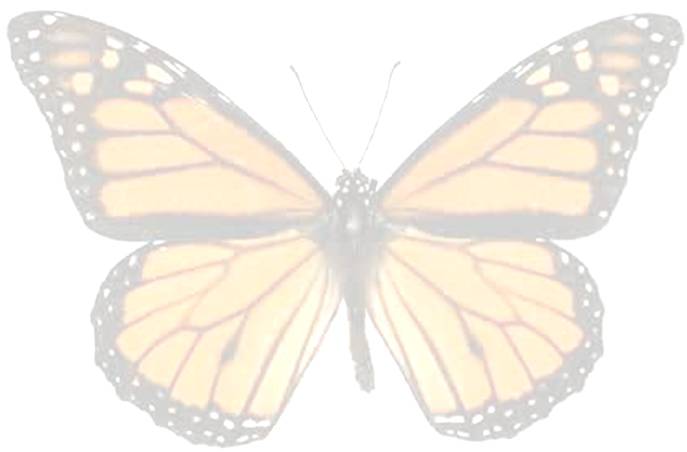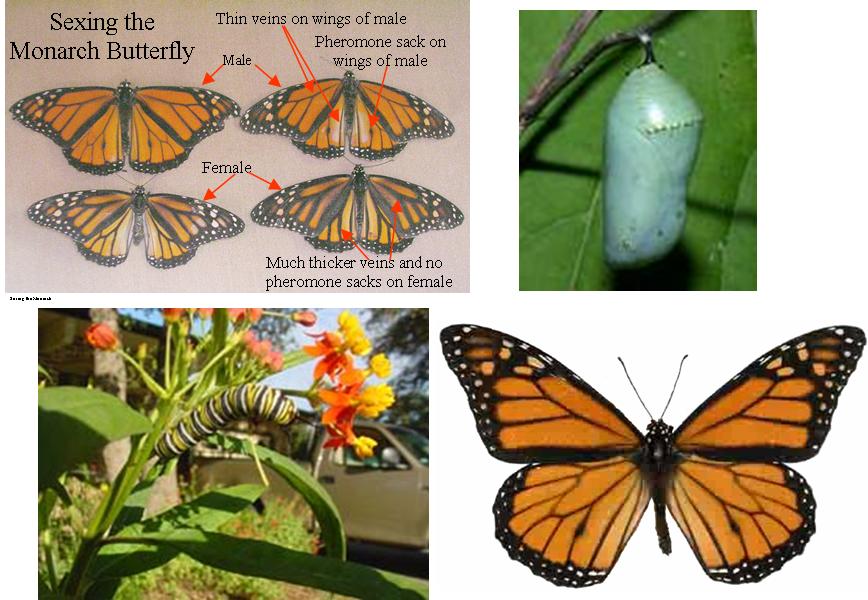
The monarch butterfly is one of the best known and beloved of all North American butterflies because they make annual migrations across America to avoid winter weather. In autumn, tens of millions of Monarch butterflies fly south and roost in huge numbers on trees in selected mountain areas of the southwest. The Monarch butterfly migrates for 2 reasons. They can not withstand freezing weather in the northern and central continental climates. Also, the larval food plants do not grow in their winter over wintering sites, so the spring generation must fly back north to regions where the plants are plentiful. Their journey can cover up to thousands of miles before it ends.
Monarchs have a wingspan of 3 3/8 - 4 7/8 inches (8.6 - 12.4 cm), and live through most of the USA, in southern Canada, Central America, most of South America, some Mediterranean countries, the Canary Islands, Australia, Hawaii, Indonesia, and many other Pacific Islands. The life span of the adult Monarch varies, depending on the season in which it emerged from the pupa and whether or not it belongs to a migratory group of Monarchs. Adults that emerged in early summer have the shortest life spans and live only for about two to five weeks. Those that emerged in late summer survive over the winter months. The migratory Monarchs, which emerge from the pupa in late summer and then migrate south, live a much longer life, about 8-9 months. The Monarch lays eggs on, and its larval stage eats only plants from the Asclepsis family (Milkweed). Milkweeds contain a potent poison, which helps to protect them from browsing animals and leaf-eating insects such grasshoppers. Monarchs are able to store this poison within their own bodies, making themselves poisonous in turn.
DMonach
Danaus plexippus

Handling: Larva can be handled carefully. The adult butterflies can be handled by pinching the two forewings together or by holding the body between two fingers.
Butterfly Food: We have found that a about a 15% sugar solution made from a 2 liter bottle of Diet 7-Up with 1 1/4 cup of added sugar works fine. The preservatives found in the 7-Up closely follow the preservatives found in recommended commercial butterfly food. (The "fizz" will soon leave the solution.) We have been using this solution for several years with great results.
Flight Cage: A minimum of 3’x3’x3’ will allow butterflies to mate and lay eggs if provided with Milkweed and above sugar solution for adult food. Screening must be included on at least one side for good air circulation with clear plastic on the other sides for good light conditions.
Disease: Several Bacterial and Viral diseases can make raising the Monarch difficult. Cleanliness, good air circulation, and sterilization of all equipment between broods can minimize the problem.
Larva: We have found that there are predator wasps that like to eat the larva found on outside milkweeds. Sometimes they can totally wipe out a monarch larval population. A simple solution is to place the egg baring milkweed in kitty litter containers (anyone who has inside cats can supply you with a "million" empty containers.) The container lids should have a 4-6 inch hole covered by wire window screen for good air circulation. Do not raise more then 20 or so larva in each container as over crowding can lead to disease conditions. Clean each cage with 10% Clorox solution before each use.
Final comment on Monarchs (and most other butterfly larva). THEY ARE LITTLE PIGGIES!!!!!!! You will be amazed at how much they will eat. We have about a hundred or more milkweed plants in pots with about twice that number planted in my various other flower gardens. (You might follow our horticulture link for pictures of such). We figure that each larva or two needs about one medium to large milkweed plant. It is lucky that Tropical Milkweed is easy to root from stem cuttings. You can also start Gay Butterfly Asclepsis seed from Burpee Seed Company


